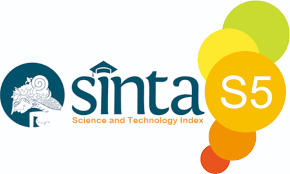PEMBELAJARAN MENGONVERSI TEKS PANTUN MENJADI TEKS DIALOG DENGAN METODE GROUP INVESTIGATION (GI)
DOI:
https://doi.org/10.22460/jler.v2i1.p49-57Kata Kunci:
Convert Learning, Panty Text, Dialog Text, Group Investigation (GIAbstrak
This research is motivated by the difficulty of students learning to convert pantun texts into dialog texts. The purpose of this study are: (1) to know the activities of teachers and students when learning. (2) knowing student responses when learning. (3) knowing the difference in learning outcomes converting pantun text into dialogue text between the experimental class and the control class. The compiler wants to know the effectiveness of the Group Investigation (GI) method in learning to convert pantun text into dialog text. The study was conducted at Mahardhika Vocational School West Bandung 2016/2017 academic year. The research method used in this study is the experimental method. The experimental design used in this study was Quasi Experimental Design (Quasi Experimental Design). This study used the control class and the experimental class. The sample used in this study were students of class XI TKR1 and TKR class XI 2 students, each class amounted to 26 people. Based on the results of the analysis it can be concluded (1) teacher activities can be carried out as much as 90% and 91.7% students, (2) The response of students in learning to convert pantun texts into dialog texts with the 92.2% Group Investigation (GI) method, 3) Results the posttest value of the experimental class with the control class is different. The number of values obtained by the experimental class is 2,081 with an average value of 80.04, while the number of values obtained in the control class is 1,349 with an average value of 51.88.
Referensi
Huda, M. (2013). Models of teaching and learning. Yogyakarta: Student Library.
Ministry of Education and Culture. (2016). Indonesia Dictionary. Jakarta: Balai Pustaka.
Mustika. "The relationship between reading interest and the habit of reading second semester students' literary works in Indonesian language and literature study programs at the Siliwangi bandung in the 2015/2016 academic year". [On line]. Scientific Journal UPT P2M STKIP Siliwangi, Vol. 2, No. 2, November 2015. [Retrieved March 29, 2018].
Nurjamilah, M. (2017). The ability to write one-round drama scripts with short story media in class VIII Junior High School nurul iman, east Jakarta. (Essay). Bachelor School, Faculty of Tarbiyah and Teacher Training, East Jakarta.
Rustina, B. et al. "The influence of cooperative learning type Investigation group types is supported by concrete media on learning outcomes of class v to class II tampaksiring". Pp. 4-5. [On line]. Available at http://download.portalgaruda.org/article.php?article=304399/1342. [February 20, 2017]
Sagala, S. (2012). The concept and meaning of learning. Bandung: Space.
Sugiyono. (2015). Quantitative, qualitative, and R & D research methods. Bandung: Alfabeta.
Tarigan, H.G. (2013). Writing as a language skill. Bandung: Space.
Toyidin. (2013). Indonesian Literature prose drama poetry. Subang: Star Library.
Wikanengsih. "Character-oriented programming learning models for improving junior high school students' writing skills." Pp. 117-186. [On line]. Available at http://journal.um.ac.id/index.php/jip/article/download/4210/1197. [Retrieved October 18, 2016]






